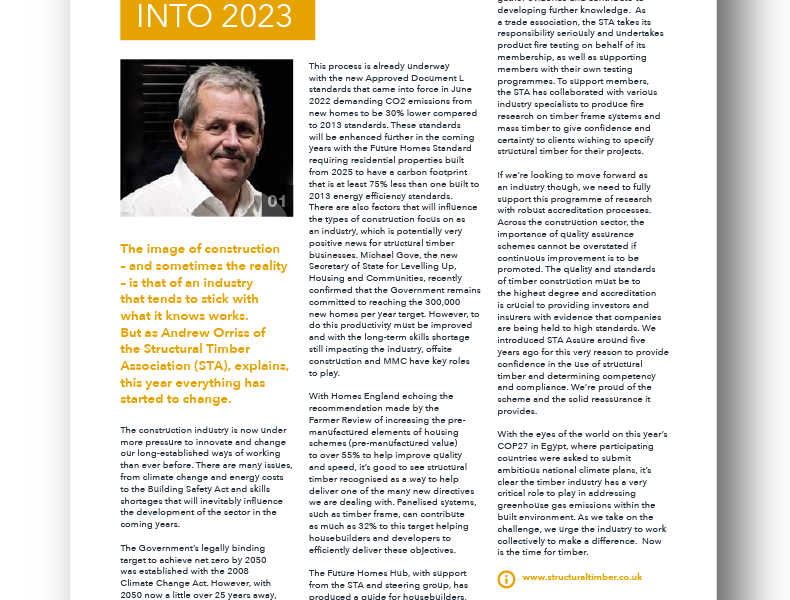Structural Timber Magazine – Moving at a pace into 2023
15/12/2022

The image, and sometimes the reality, of construction is that of an industry that tends to stick with what we know works. Here, Andrew Orriss of the Structural Timber Association discusses why this year, the appetite for structural timber is picking up. Exhausting or exciting? Let’s find out.
The construction industry is now under more pressure to innovate and change our long-established ways of working than ever before. There are many issues, from climate change and energy costs to the Building Safety Act and skills shortages that will inevitably influence the development of the sector in the coming years.
The Government’s legally binding target to achieve net zero by 2050 was established with the 2008 Climate Change Act. However, with 2050 now a little over 25 years away, there is growing urgency to address greenhouse gas emissions – especially those associated with our built environment, which accounts for 25% of the UK’s total emissions. With this comes new regulations and standards that will undoubtedly require a change in how we build.
This process is already underway with the new Approved Document L standards that came into force in June 2022 demanding CO2 emissions from new homes to be 30% lower compared to 2013 standards. These standards will be enhanced further in the coming years with the Future Homes Standard requiring residential properties built from 2025 to have a carbon footprint that is at least 75% less than one built to 2013 energy efficiency standards.
There are also factors that will influence the types of construction focus on as an industry, which is potentially very positive news for structural timber businesses. Michael Gove, the new Secretary of State for Levelling Up, Housing and Communities, recently confirmed that the Government remains committed to reaching the 300,000 new homes per year target[1]. However, to do this productivity must be improved and with the long-term skills shortage still impacting the industry, offsite construction and MMC have key roles to play.
With Homes England echoing the recommendation made by the Farmer Review of increasing the pre-manufactured elements of housing schemes (pre-manufactured value) to over 55% to help improve quality and speed, it’s good to see structural timber recognised as a way to help deliver one of the many new directives we are dealing with. Panelised systems, such as timber frame, can contribute as much as 32% to this target helping housebuilders and developers to efficiently deliver these objectives.
The Future Homes Hub, with support from the STA and steering group, has produced a guide for housebuilders, designers and their advisors of how to deliver homes to the new Approved Document Part L (2021). The guide looks at a range of built forms and then at a variety of fabric (including Future Homes Standard type solutions) and service approaches to achieve the same goals[2].
As a key part of any continued development programme, research is paramount to inform action, gather evidence and contribute to developing further knowledge. As a trade association, the STA takes its responsibility seriously and undertakes product fire testing on behalf of its membership, as well as supporting members with their own testing programmes.
To support members, the STA has collaborated with various industry specialists to produce fire research on timber frame systems and mass timber to give confidence and certainty to clients wishing to specify structural timber for their projects. The STA has worked with BE-ST (Built Environment – Smarter Transformation) formerly Construction Scotland Innovation Centre (CSIC), the University of Edinburgh, and BRE to produce various research reports and has also formed special interest groups to address specific research and testing requirements.
If we’re looking to move forward as an industry though, we need to fully support this programme of research with robust accreditation processes. Across the construction sector, the importance of quality assurance schemes cannot be overstated if continuous improvement is to be promoted. The quality and standards of timber construction must be to the highest degree; therefore, accreditation is crucial to providing investors and insurers with evidence that companies are being held to high standards.
We introduced STA Assure around five years ago for this very reason; the STA’s Quality Assurance Scheme for members, providing confidence in the use of structural timber and determining competency and compliance. We’re proud of the scheme and the solid reassurance it provides that those structural timber suppliers (members of STA), will supply products and systems to an audited quality scheme, meeting or exceeding current legislation and regulatory requirements.
With the eyes of the world on this year’s COP27 in Egypt, where participating countries were asked to submit ambitious national climate plans, it’s clear the timber industry has a very critical role to play in addressing greenhouse gas emissions within the built environment. As we take on the challenge, we urge the industry to work collectively to make a difference. Now is the time for timber!
Click here to read full article.